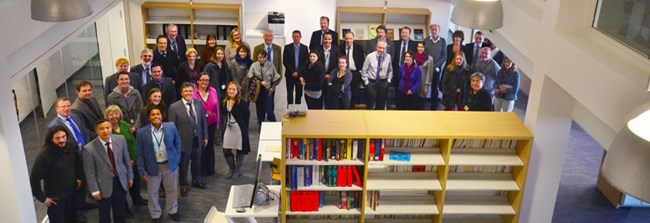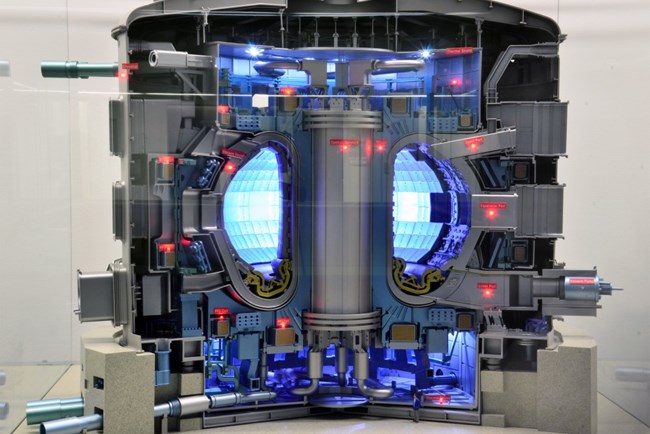
On 29 November 2012, all those who were present in the COMPASS control room cheered when distinctive H‐mode operation was observed for the first time since the tokamak had been reinstalled in the Institute of Plasma Physics in Prague in 2008. The H‐mode or "high confinement mode" refers to a sudden improvement of plasma confinement in the magnetic field of tokamaks—approximately by a factor of two—and is foreseen as the standard mode of operation for ITER. The first H‐mode operation in COMPASS was achieved with the 210 kW neutral beam heating: ten milliseconds after the beam injection started, the intensity of visible light known as the Dα radiation suddenly decreased and the plasma stored energy and density considerably increased. The day after, on 30 November 2012, Ohmic H‐mode operation (i.e., without the beam heating) was achieved during the intentional current ramp‐down phase of the discharge. Transition from Type III ELM (Edge Localized Mode) instabilities to ELM-free H‐mode operation was observed. In the experiments, the COMPASS plasmas were confined in the divertor configuration, just like the JET and ITER plasma configurations, although five and ten times smaller in linear dimensions, respectively. Mastering H‐mode was very important to the COMPASS team in order to perform similar experiments in support of the large fusion facilities. In this respect, the COMPASS Tokamak is well equipped with diagnostic systems for studies of the plasma edge, where the so‐called pedestal of the H‐mode is located (the region of plasma edge where pressure increases sharply). The H‐mode pedestal forms in the region of the plasma transport barrier, which is behind the improved plasma confinement. Better insight into physics of this narrow plasma region is required in order to enhance control of the power flux, plasma heating and the ELM instabilities in fusion reactors.
After the December 2011 edition of the ITER Business Forum, which gathered more than 600 participants from 20 European countries, the 2013 edition (IBF/13) will take place in Toulon, France, on 21-22 March with the participation and support of the ITER Organization and the European Domestic Agency, Fusion for Energy (F4E). This event has been organized by the F4E Industrial Liaison Officers Network, with the support of the Toulon Tourist Office and the Var Chamber of Commerce and Industry. Between 600 and 800 participants are expected.
The aims of IBF/13 are to provide European industry with updated information on ITER status, procurement procedures and forthcoming calls for tenders; to improve mutual knowledge between the ITER Project and industrialists; to facilitate industrial partnerships for ITER within—and outside of—Europe; to facilitate contacts between fusion research laboratories and industry; and to facilitate the recruitment by industry, ITER and Euratom associations of young people trained in nuclear fusion technologies.
IBF/13 will feature an industrial conference with a plenary session and thematic workshops, one-to-one meetings scheduled online by participants, a poster session by trainees of EFDA program "Goal Oriented Training," a Welcome Reception, and a Gala Dinner for networking purposes.
Optional activities include a visit of the ITER site, a discovery tour of Toulon's economic potential, or sightseeing tours organized from 20-23 March.
Thematic workshops will consist of presentations by ITER Organization and F4E technical experts, as well as short presentations from ITER prime contractors or pre-qualified companies (Rank 1) from Europe (and also from Korea, India and the United States). These are aimed at facilitating contacts with potential partners or subcontractors at the European or international level.
IBF/13 provides a unique opportunity to make business contacts with European companies relating to the ITER Project and, more largely, to your core business.
The complete program of the ITER Business Forum 2013 and online registration can be found at www.iterbusinessforum.com. Please contact your national Industrial Liaison Officer (ILO) for any additional information.
|
ITER, the world's first reactor-scale fusion machine, will have a plasma volume more than 10 times that of the next largest tokamak, JET. Plasma disruptions that can occur in a tokamak when the plasma becomes unstable can potentially damage plasma-facing surfaces of the machine. To lessen the impact of high energy plasma disruptions, US ITER is engaged in a global research effort to develop disruption mitigation strategies.
US ITER, managed by Oak Ridge National Laboratory, will continue working closely with global partners on the ITER disruption mitigation system, as the 2016 deadline for design of the system rapidly approaches. To continue moving R&D forward, an early conceptual design review was supported by US ITER in November.
Larry Baylor, a distinguished scientist in ORNL's Fusion Energy Division, says that the disruption mitigation system needs to accomplish two main objectives: To reduce the thermal energy of the plasma and to diminish the effects of "runaway electrons" that can form as a result of the disruption.
"A disruption occurs when the plasma becomes unstable and starts to move uncontrollably. You have to cool the plasma down quickly so that it does not hit the wall with that thermal energy," notes Baylor. "Tokamaks have a current inside the plasma. In a disruption, that current decays fairly quickly and it has a side effect of generating a voltage in the plasma, called a 'loop voltage.' And that loop voltage can cause electrons that are already in the plasma to speed up to very high energies. We call those runaway electrons."
Thermal quench and current quench studies are part of the research underway on disruption mitigation and runaway electron suppression.
Two main concepts are under consideration for disruption mitigation. Massive gas injection quickly injects gases such as neon or argon into the plasma. Shattered pellet injection uses wine cork-sized cryogenic pellets, mostly of neon and deuterium, to insert many small fragments of solid along with gas and liquid into the plasma. For both concepts, it is crucial that the system respond very quickly to potential disruptions.
Earlier in 2012, Nicolas Commaux, an ORNL fusion energy scientist, was awarded a USD 2.5 million early career grant by the DOE Office of Science for further work on disruption systems. Commaux notes that important findings have been made about how to use massive gas injection to affect the location and behavior of electron beams in the plasma. Investigations are ongoing and further developments are anticipated in 2013.
Much of the research within the US has been taking place at DIII-D, a tokamak managed by General Atomics for the Department of Energy in San Diego, California. This tokamak offers a number of advantages for disruption studies, as it is compact and extremely resilient.
Commaux observes, "Disruption mitigation experiments are usually rather unpopular for the machine because we deliberately trigger disruptions. But DIII-D is well equipped with thick carbon tiles to protect the walls."
Reporting provided by Agatha Bardoel.
A delegation of members of the Korean National Assembly, accompanied by the head of the ITER Korean Domestic Agency Kijung Jung, visited the ITER worksite on 3 January in order to survey ITER progress and congratulate the ITER Organization on the inauguration of the ITER Headquarters scheduled for Thursday 17 January.
During the visit, which they qualified as "impressive," the delegates were welcomed by ITER Director-General Osamu Motojima, who said, "I would like to thank the delegation members for Korea's constant support and large contribution to the ITER project and to the Korean Domestic Agency for ITER."
The head of delegation of Shin Hak Yong, Chairman of Standing Committee for Education, Science and Technology, commented: "Following its visit of the ITER worksite, the National Assembly was delighted to see the successful progress of ITER. We will make sure to continue to support the ITER Project."
"Benefiting from such confidence and having such support is very important to the ITER Project and is very encouraging for us all," said Director-General Motojima during discussions with the Korean guests.
|







